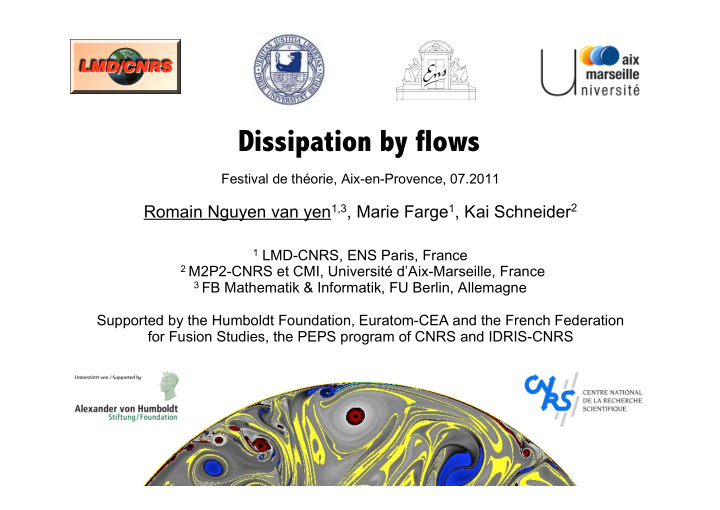



Dissipation by flows Festival de théorie, Aix-en-Provence, 07.2011 Romain Nguyen van yen 1,3 , Marie Farge 1 , Kai Schneider 2 1 LMD-CNRS, ENS Paris, France 2 M2P2-CNRS et CMI, Université d’Aix-Marseille, France 3 FB Mathematik & Informatik, FU Berlin, Allemagne Supported by the Humboldt Foundation, Euratom-CEA and the French Federation for Fusion Studies, the PEPS program of CNRS and IDRIS-CNRS
2 Outline 1. Introduction: dissipative singularities, macroscopic randomization, and wavelets. 2. 2D periodic Navier-Stokes turbulence – Methodology – Molecular dissipation – Wavelet-based macroscopic dissipation 3. 2D wall-bounded Navier-Stokes (1 slide)
black slide
4 Graphical examples Earth (Apollo 17) Biker in a wind tunnel Ultraviolet sun (TRACE, NASA) Mast tokamak (CCFE, UK)
5 A first attempt: molecular dissipation • Flows = collective motions of many particles described macroscopically. • Prediction usually impossible from principles of Lagrangian mechanics. • But statistical assumptions are possible. • The main statistical assumption is the closeness to a certain statistical equilibrium (local thermodynamic equilibrium, molecular chaos…), • Global relaxation can usually be proved (growth of entropy), • This phenomenon is called molecular dissipation. R. Balian, From microphyics to macrophysics , Springer (2006)
6 Not the end of the story • For example in incompressible Navier-Stokes this leads to the equation: This coefficient may be very small ! • In practice relaxation often occurs on time-scales that are independent on microscopic coupling coefficients .
7 Ways out of this paradox 1. Singular behavior counteracts the smallness of the coupling coefficient and opens access to microscopic dissipation 2. Microscopic dissipation is not the relevant relaxation energy dissipation rate measured experimentally in flows behind grids mechanism anymore, another relaxation takes over (possibly associated to a macroscopic statistical equilibrium). 3. A combination of the above two. 0 Molecular dissipation becomes Re- Example : Burgers equation independent flow entropy Example : T.D. Lee equilibria in Galerkin truncated systems. Fig. from Sreenisvasan (1984) Landau damping (isentropic relaxation)
8 Dissipation as randomization trajectory of reduced model time
9 Dissipation as randomization trajectories of a more complete model Dissipation can be seen as voluntary forgetfulness. The goal is to make predictions from incomplete knowledge. time
10 Flow dissipation seen in Fourier space position Critique of Kraichnan FINE SCALE Nonlinear interaction at a given scale and Nonlinear transfer between scales occur on the same timescale ! In other words, there is no good reason COARSE SCALE to think that the flow is better equilibrated at fine scales than at coarse scales. L.F. Richardson, Diffusion regarded as a compensation for smoothing (1930) R.H. Kraichnan, On Kolmogorov’s inertial range theories (1974)
11 Flow dissipation seen in wavelet space INCOHERENT FINE SCALE COARSE SCALE COHERENT
12 Orthogonal wavelet bases scaling function wavelet energy spectra
13 Orthogonal wavelet bases dilated / translated wavelets corresponding energy spectra
14 Orthogonal wavelet bases 2d scaling function and wavelets
15 Wavelets and spatial localization Brownian motion Two-step function
16 Wavelet nonlinear thresholding • Orthogonal wavelet decomposition: , where • Idea: split wavelet coefficients between two sets, “ large coefficients” and “ small coefficients”: Where large and small are defined with respect to a certain threshold: or D. Donoho & I. Johnstone (1992), M. Farge, N. Kevlahan, K. Schneider (1999)
17 Navier-Stokes initial-boundary value problem Equation (no body forces decaying flow) Boundary conditions : periodic Initial conditions In 2D this is a well-posed problem
18 Molecular dissipation in 2D Navier-Stokes energy enstrophy vorticity
19 Numerical study initial condition Re ≈ 17 000 Re ≈ 66 000 min max 0 time evolution time evolution time evolution Re ≈ 266 000 Re ≈ 1062 000 Re ≈ 4 248 000
20 Numerical study max 0 min
21 Energy dissipation at vanishing viscosity? increasing Re
22 Enstrophy dissipation at vanishing viscosity? increasing Re
23 Enstrophy dissipation at vanishing viscosity? Tran & Dritschel, JFM 559 (2006): “There is no Re-independent measure of dissipation”
24 Scale-wise statistics
25 Wavelet denoising = +
26 Scale-wise coherent vorticity extraction PDF of wavelet coefficients at scale j=8 The threshold is defined at each scale by: constant standard parameter deviation Total vorticity Coherent vorticity Incoherent vorticity = +
27 Statistical properties of the split • The global PDF of the incoherent part is close to a Gaussian
28 Statistical properties of the split -3
29 Dissipation of coherent enstrophy MOLECULAR DISSIPATION DISSIPATION OF COHERENT ENSTROPHY INCOHERENT ENSTROPHY
30 Inter-scale and intra-scale transfers Ex: j = 9 negative dissipation intra-scale transfer
31 Retroaction of the dissipated flow • Model the incoherent wavelet coefficients by random variables, • Maximum entropy distribution, with constraints: (1) (2) (3) It doesn’t fit, but we proceed anyway.
32 Retroaction of the dissipated flow
33 Summary • We have introduced a “dissipation mechanism” for 2D turbulence based on a split of the flow between explicit and dissipated components. • The associated enstrophy dissipation rate does not vanish at vanishing viscosity. • The dissipation rate can be directly related to the nonlinear transfers and studied quantitatively scale-wise. • Negative dissipation is allowed. • We have shown that the retroaction of the dissipated flow has a diffusive effect on the explicit flow at short times. R.H. Kraichnan, Reduced descriptions of hydrodynamic turbulence (1988) R.H. Kraichnan & S. Chen Is there a statistical mechanics of turbulence? (1989) RNVY, M. Farge, K. Schneider, doi: 10.1016/j.physd.2011.05.022
34 A result on dissipative singularities • There are no dissipative singularities in 2D Navier-Stokes in the absence of walls and for bounded vorticity fields. • However this happens in the presence of boundaries. time RNVY, M. Farge, K. Schneider, PRL 106 , 184502
35 Acknowledgements • Thanks to Claude Bardos, Dmitry Kolomenskiy, Xavier Garbet, Greg Hammett, any many others. • The Kicksey-Winsey code can be downloaded at : http://justpmf.com/romain • Papers are available on : http://wavelets.ens.fr/ Thank you!
36 Le temps efface tout comme effacent les vagues Les travaux des enfants sur le sable aplani Nous oublierons ces mots si précis et si vagues Derrière qui chacun nous sentions l'infini. Marcel Proust
Recommend
More recommend